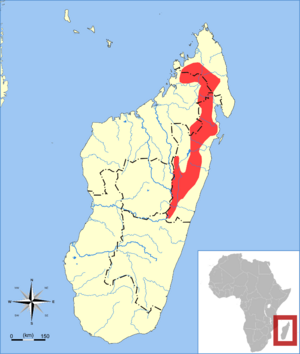Grandidier's tufted-tailed rat facts for kids
Quick facts for kids Grandidier's tufted-tailed rat |
|
|---|---|
| Conservation status | |
| Scientific classification | |
| Genus: |
Eliurus
|
| Species: |
grandidieri
|
 |
|
| 2011 range | |
The Grandidier's tufted-tailed rat (Eliurus grandidieri) is a type of rodent, which is a group of mammals that includes rats, mice, and squirrels. It belongs to the Nesomyidae family, a group of rodents mostly found in Africa and Madagascar. This rat is closely related to Petter's tufted-tailed rat, E. petteri. However, the Grandidier's tufted-tailed rat is smaller than its cousin.
Contents
What is the Grandidier's Tufted-Tailed Rat?
This special rat was first described in 1998 by scientists Michael D. Carleton and Goodman. It gets its name from Grandidier, a famous French naturalist. Like other rats in its family, it has a tail that looks a bit bushy or "tufted" at the end.
Where Does This Rat Live? (Distribution)
The Grandidier's tufted-tailed rat lives only on the island of Madagascar. This means it is endemic to Madagascar, found nowhere else in the world. It prefers to live in forests high up in the mountains. You can find it between 1,250 and 1,875 meters (about 4,100 to 6,150 feet) above sea level. It lives in the northern and central parts of eastern Madagascar.
Its Home and Habits (Habitat and Ecology)
This rat makes its home in sclerophyllous forests. These are forests with trees and plants that have hard, stiff leaves, which help them survive in dry conditions. Scientists believe this rat is partly scansorial. This means it spends time both on the ground and climbing in trees.
The Grandidier's tufted-tailed rat depends on forests to live. It has not been found in open grasslands or outside forest areas. It might live just below the line where trees stop growing on mountains.
How Does It Reproduce?
Female Grandidier's tufted-tailed rats are thought to give birth to small litters. They usually have up to three young at a time. This helps new generations of these unique rats continue to thrive in their forest homes.
Is This Rat Safe? (Conservation Status)
The Grandidier's tufted-tailed rat is listed as "Least Concern" on the IUCN Red List. This means it is not currently considered to be in danger of disappearing. It lives in many different places across its range. However, we don't know if its total population is growing, shrinking, or staying the same.
One threat to this rat's home is deforestation. This is when forests are cut down to make space for farms. Even with some forest loss, there isn't enough to make the rat's status more threatened right now.
Another concern for all rats in the Nesomyidae family is disease. They can get sick from diseases carried by other types of rats that have been brought to Madagascar. These diseases can sometimes cause many rats to die in certain areas.
Luckily, the Grandidier's tufted-tailed rat lives in three protected areas. These are the Anjanaharibe-Sud Special Reserve, the Manongarivo Special Reserve, and the Marojejy National Park. These protected places help keep their homes safe.


